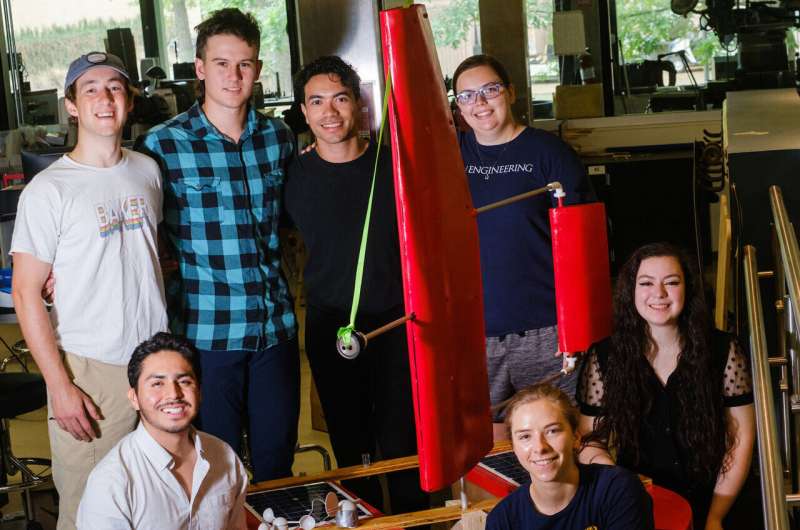This article has been reviewed according to Science X's editorial process and policies. Editors have highlighted the following attributes while ensuring the content's credibility:
fact-checked
trusted source
proofread
Self-navigating catamaran can carry cargo into war zones

A self-navigating, cargo-carrying sailboat designed by Rice University engineering students could be a sustaining link for Marines hunkered down on shore during war.
The members of the Alive team—Freddy Angarita-Cuesta, Anna Frey, Jessica Kies, Alan Lopez, Oli MacGregor, Wyeth McKinley and Scarlett Spindler—built the low-cost, energy-efficient vessel as their senior design capstone project. The goal is to carry 60 pounds of cargo or more.
"Most of the existing autonomous sailboat designs out there are usually targeted toward ocean research or racing," Frey said. "That means they're super lightweight, not meant for carrying cargo."
"This is the first autonomous catamaran sail design that we know of that's intended to bear load," MacGregor added.
The project's engineering demands entail mechanical, electrical and programming components. The challenge highlights the interdisciplinary nature of the Oshman Engineering Design Kitchen's annual showcase and competition, which features problem-solving at its finest—and over $19,000 in prizes.
Alive—which stands for autonomous low-impact vessel—was one of 69 teams to compete in this year's edition of the iconic event put on by Rice's George R. Brown School of Engineering. Their project was the recipient of an Excellence in Capstone Engineering Award and a $1,000 prize.
The team's sponsor, Marine Corps Lt. Col. Thomas Kline, approached its mentors with a proposal to develop an expendable, autonomous, energy-efficient sailboat at low cost that could carry cargo onto contested shores.
"The central idea is to make an adversary choose whether or not to use expensive weapons on cheap targets," Kline said. "If they do not, Marines get resupplied. If they do, but some sailboats get through, Marines get resupplied. Win-win."
"We all thought that was a cool project and put it down as our top choice," Frey said.
Frey, a mechanical engineering major, was in charge of designing the rudder, sail and body of the vessel. "Because it's an airfoil shape, the sail creates lift when you angle it in the wind—it's basically a sideways airplane wing, which propels the boat," she said. "The wind vane in the back helps guide the sail into position."
The vessel is equipped with a number of sensors integrated into a self-correcting navigation system.
"There's a couple of main subsystems in the boat," MacGregor said. "You've got a sensor that measures the direction of the wind. The GPS sensor gives the current coordinates of the boat. You've got a magnetometer, which is a digital compass that can tell you your bearings and where you're facing. That helps determine which direction the boat should be going and how it should position its wind vane."
In favorable wind conditions, the boat adjusts its course to a trajectory devised using the coordinates of its current location and those of its target destination. However, things get more complicated if the boat is sailing against the wind in a so-called " no-go zone" where it cannot generate lift due to the opposing wind direction.
"That's actually been the most challenging aspect of this project," MacGregor said.
"Whenever the destination is in the no-go zone, the boat cannot approach it via a direct route," Angarita-Cuesta said. "So the main idea to get around this is to create a series of artificial or temporal waypoint targets alternating along either side of the no-go zone perimeter in a zigzag pattern."
The students are also working on equipping the boat with a communication link to a satellite network that would allow it to stream back data from any location around the globe for further engineering development.
"The communications module that connects the vessel to the satellite constellation gives us the ability to send data back to the ground station," Lopez said. "We're going to collect all of the sensor data, including the magnetometer information, the bearing, the wind speed, the current GPS location, etc., so that we can use it to debug and improve our tests as well as to check our progress."
The students' choice of materials and component parts sought to optimize the cost-to-efficiency ratio. Moreover, autonomy was a guiding design principle not only in terms of navigation, but also with respect to energy consumption.
"It's all solar-powered," MacGregor said. "It produces enough electricity through its solar panels to power the systems several times over. It also collects excess energy in batteries that live on the boat. So, in cloudy weather or at nighttime, it can still power itself."
The team's faculty advisers were mechanical engineering lecturer David Trevas and Gary Woods, a professor in the practice of electrical and computer engineering.




















